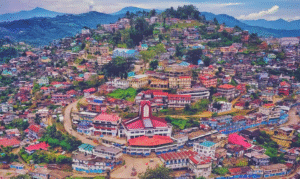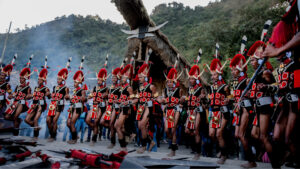Introduction
Nestled in the serene hills of Nagaland’s capital city, Kohima War Cemetery is a solemn and dignified tribute to the valiant soldiers who laid down their lives during the Second World War. Maintained by the Commonwealth War Graves Commission (CWGC), this cemetery is not just a burial ground—it is a poignant reminder of one of the fiercest battles ever fought on Indian soil. The Battle of Kohima, often referred to as the “Stalingrad of the East,” was a turning point in the Burma Campaign of World War II.
This blog takes a comprehensive and academic look at the Kohima War Cemetery, tracing its historical relevance, architectural features, and cultural significance. It explores how the site not only commemorates bravery and sacrifice but also fosters a dialogue between past and present, conflict and peace, memory and history.
The Historical Context: Battle of Kohima
To understand the significance of the Kohima War Cemetery, one must first delve into the events that led to its creation. In 1944, during the height of World War II, the Japanese Imperial Army launched an aggressive campaign into British India from Burma. Their goal was to capture key strategic positions in the Northeast and cut off Allied supply lines, particularly the lifeline between Dimapur and Imphal.
The town of Kohima, perched on a ridge and connected by this crucial supply route, became the site of a three-month-long battle from April to June 1944. The British Fourteenth Army, composed of British, Indian, and Gurkha troops, faced off against a strong and determined Japanese force. The battle was fought in extremely difficult terrain, with steep hills, dense forests, and relentless monsoon rains creating nearly insurmountable obstacles.
One of the most iconic parts of the battle took place at the Deputy Commissioner’s Bungalow, where the two sides were engaged in brutal, close-range combat over a tennis court. This site is now preserved within the cemetery grounds. The successful defense and counteroffensive mounted by the Allied troops eventually forced the Japanese forces to retreat, marking a decisive moment in the war’s Asian theatre.
Establishment of the War Cemetery
In the aftermath of the battle, the Commonwealth War Graves Commission took on the responsibility of identifying and honoring the fallen soldiers. The Kohima War Cemetery was established on the very site where much of the fighting occurred. The cemetery was meticulously planned, with great respect shown to both the terrain and the memory of the fallen.
It contains over 1,420 Commonwealth burials, including soldiers from Britain, India, and other Allied nations. Additionally, it commemorates nearly 917 soldiers whose bodies were never recovered or identified, inscribed on the memorial panels within the site.
The cemetery was designed by Colin St Clair Oakes, a British architect known for designing war cemeteries in Asia. Oakes incorporated the natural contours of the hillside and integrated local Naga architectural influences, creating a space that is both respectful and regionally rooted.
Layout and Architectural Features
The cemetery is laid out in terraces along the hillside, preserving the original site of the battle. The headstones are arranged in rows on these terraces, facing upward to the sky, a symbolic gesture of remembrance. Each headstone is inscribed with the soldier’s name, rank, regiment, date of death, and religious symbol.
At the center of the cemetery stands the Cross of Sacrifice, a tall, slender stone cross with a bronze sword embedded in it. This emblem is found in many Commonwealth war cemeteries and serves as a unifying symbol of collective sacrifice.
Another prominent feature is the Kohima Cremation Memorial, dedicated to Hindu and Sikh soldiers who were cremated in accordance with their religious traditions. Their names are inscribed on a curved wall, integrating spiritual sensitivity into military commemoration.
Of particular note is the epitaph at the entrance, which reads:
“When you go home, tell them of us and say:
For your tomorrow, we gave our today.”
This moving tribute, attributed to John Maxwell Edmonds, has become one of the most iconic war memorial inscriptions globally and encapsulates the spirit of ultimate sacrifice.
Cultural and Educational Significance
While the Kohima War Cemetery is a site of military and historical importance, it also holds deep cultural value for the region. The people of Nagaland, particularly the residents of Kohima, were witness to the brutal battle and have continued to play a role in maintaining the memory of those who perished.
Every year, the cemetery hosts remembrance ceremonies on significant occasions such as ANZAC Day (April 25) and Kohima Day (April 14). Dignitaries from the United Kingdom, India, and other nations visit to lay wreaths, offer prayers, and read out the names of the fallen.
For local schools and universities, the cemetery also functions as an open-air history lesson. Students and researchers frequently visit the site to understand not only the events of World War II but also the global nature of war, the concept of valor, and the ethics of remembrance.
Moreover, the cemetery bridges cultural divides. The interred include soldiers from different nations, languages, and religions—demonstrating the collaborative yet costly effort made in pursuit of freedom during a time of global conflict.
Kohima War Cemetery in the Context of Northeast India
The existence of such a significant WWII site in Nagaland underlines the strategic importance of Northeast India during the global conflict. Historically marginalized in national narratives, the Northeast played a crucial yet often overlooked role in the defense of the Indian subcontinent.
Kohima War Cemetery brings to light the military and civilian efforts of the people in this region. Naga tribes, for instance, aided the British by acting as guides, porters, and informants. Their role in resisting Japanese advancement and aiding Allied logistics was critical to the war effort.
The cemetery, therefore, stands as a dual monument—honoring both the soldiers who died and the indigenous communities who endured wartime hardships.
Conservation and Global Recognition
The Commonwealth War Graves Commission has ensured the preservation of Kohima War Cemetery to the highest standards. The landscaped lawns, well-maintained headstones, and multilingual information panels reflect ongoing efforts to make the site both dignified and accessible.
In 2013, the cemetery was listed among the top 10 must-visit war memorials in the world by the UK’s National Army Museum. This international recognition has increased awareness of the site and attracted visitors from across the globe, including war veterans, descendants of soldiers, and historians.
Efforts have also been made to digitize records and make soldier information available online. This digital accessibility helps researchers and relatives of the deceased connect with the personal stories behind the statistics, ensuring that the cemetery remains a living archive rather than a forgotten relic.
Challenges and Preservation
Despite its importance, the cemetery faces certain challenges. The hilly terrain and seasonal rains require continuous upkeep to prevent erosion and structural degradation. There are also ongoing concerns about accessibility for elderly visitors and veterans due to the steep landscape.
Urban expansion in Kohima city and the growing pressure of tourism need to be managed carefully to avoid encroaching on the sanctity of the site. Local authorities, in collaboration with the CWGC and heritage bodies, are working to ensure that development does not compromise the solemn nature of the cemetery.
Public awareness campaigns and guided educational tours have also been introduced to inculcate respect among visitors and prevent casual tourism that might disrespect the site’s dignity.
Symbolism and Global Peace Narrative
The Kohima War Cemetery transcends its function as a military memorial. It is a symbol of reconciliation, unity, and peace. In a world still marred by conflict and political divisions, sites like Kohima serve as reminders of shared histories and collective loss.
The cemetery promotes a narrative that moves beyond nationalistic valor and emphasizes the human cost of war. Each headstone tells a story of courage, separation, and often, youth lost too soon. The inclusion of soldiers from multiple faiths, regions, and cultures affirms the idea that humanity’s struggles and triumphs are interconnected.
Conclusion
Kohima War Cemetery stands as a timeless monument in the misty hills of Nagaland—where soldiers of varied backgrounds found eternal rest after one of the most grueling battles of the Second World War. It is more than a resting place; it is a landscape of memory, sacrifice, and global solidarity.
As the world continues to navigate political uncertainties and regional conflicts, the cemetery calls for reflection. It invites visitors—young and old, local and foreign—to walk its paths with reverence and emerge with a deeper understanding of history’s lessons.
In preserving the past with such care, Kohima War Cemetery contributes not only to historical awareness but also to a future grounded in peace, empathy, and mutual respect.






